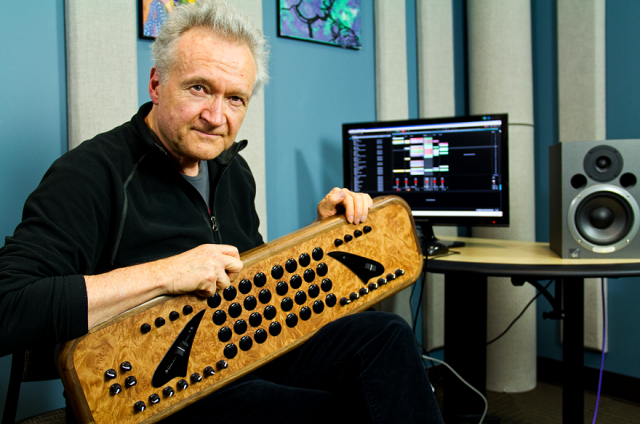In a world of disposable computers and electronics, making something “custom” is an antidote to throwaway hardware, a way of putting one’s own handiwork, care, and attention into the object with which you play music. Of course, it’s one thing to say it, and another thing to do it, but Nick Francis falls squarely in the “doer” camp. A jazz-focused radio broadcaster from Seattle’s KPLU, Nick says he’s been chopping up audio since he was doing it with razor blades and tape. Naturally, his digital music controller has the kind of craft in wood that you’d normally find on an acoustic instrument – and his music remixes of choice tend toward artists like Coltrane.
Nick’s work also combines resources from the Web. He says he got started because of a post here on CDM, then went to Livid’s DIY solution, the Builder DIY system, and DJ TechTools’ arcade buttons.
Nick has build details on DJ TechTools, as posted in March:
The Chopper Tone – Classic Arcade Custom Controller [DJ Tech Tools]
Updated: Livid, whose Builder series powered the guts of the project and made it possible, did an extensive Q&A.
And today, he shared his work on his own KPLU radio station site, sharing how he works with remixing classic jazz tunes on the controller.
Mix it up: KPLU music director invents ‘The Choppertone’
Nick shares some additional thoughts for CDM – and I reproduce them, really, because just as he feels indebted to CDM, I feel personally indebted to everyone who shares their work with us on this site and in this community in general:
This project never would’ve happened had I not stumbled upon your website in 2009 or so. I really love your wide-open approach to this whole world of geeks, tinkerers, engineers and artists who make up the core of your community.
Regarding the actual build of the Choppertone, I pretty much covered it in detail in my initial postings to the forums at Livid and DJTT. The whole build process was really challenging, yet extremely rewarding. Nothing beats the feeling of spending months of detailed work on a project, finally getting it done, and then seeing it work!
I basically recorded the video for a few friends who had no idea what controllers were about. I tried to find something simple enough musically to demonstrate it. One of the fun things about jazz is that historically, from the get-go, these musicians were the original “remixers”; they could take a melody, tune or phrase, and tweak it, rearrange it and make it their own. I had been lately been listening to a lot of Fats Waller, so “Honeysuckle Rose” was a good fit. I found at least 20 versions of it in the KPLU library, and chose four that were close to the original key and tempo. From there it was just a few days of chopping everything into 4 bar phrases, then finding the ones that seemed to play well with the others.
As for how I thought the video would be received by the midi controller community, I had no idea. I sensed that this project was going to come off as either really cool…or really stupid. All I knew is that it worked for me.
The positive response to the video has simply blown my mind, and the video’s reach has extended far beyond what I imagined. I could not believe my eyes when I received an email from the Ableton offices in Berlin a few weeks ago. That was so incredibly cool. I’m also quite amused by the many comments regarding my age; I have to tell you that my creative spirit is as vibrant now (at 61) as it was when I was an aspiring film student at UCLA at 21. These days, I’m quite aware that my days on earth are limited and that the present moment is to be savored. That’s all you got.
I imagine a number of the sentiments there will be familiar – and I certainly find interests in our wider community that transcend age (and other) barriers.
Nick says he’s woodshedding so that this is something he can use in live sets. He also says he welcomes questions, so readers, if you’ve got them, let’s hear!
